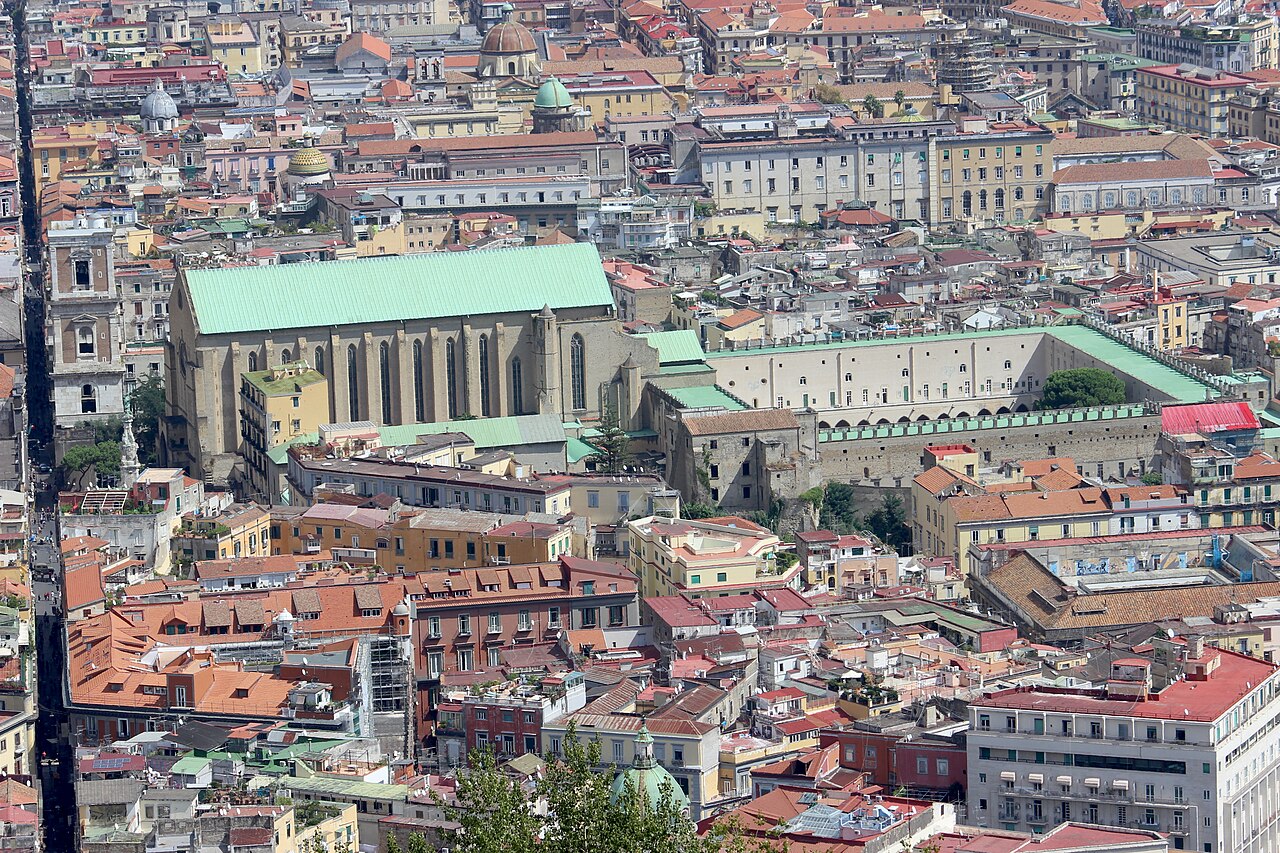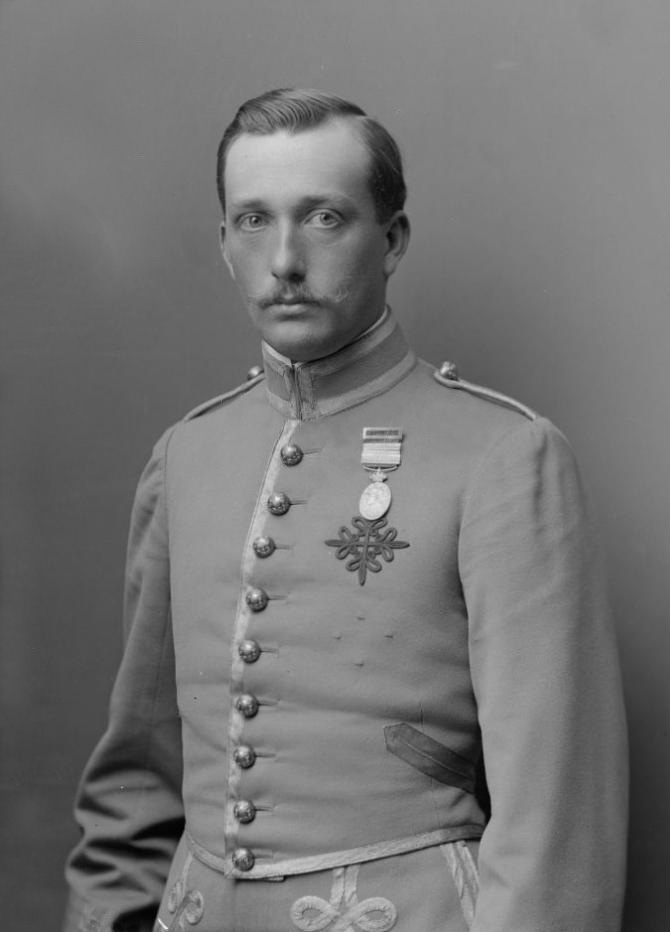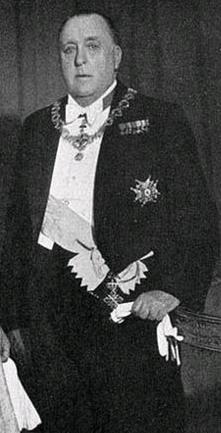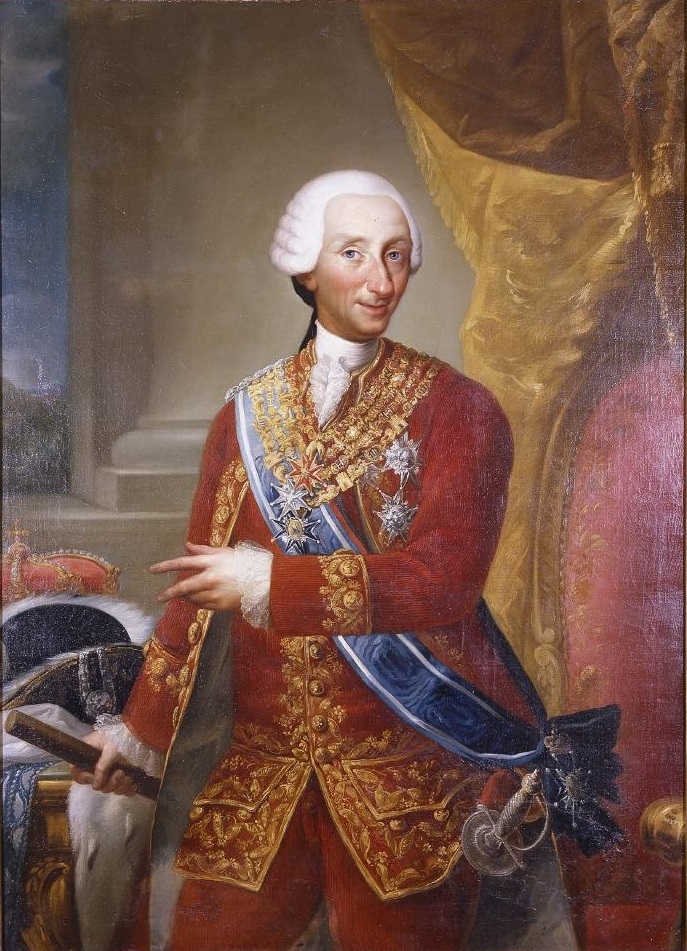by Susan Flantzer
© Unofficial Royalty 2022

The Basilica of Santa Chiara with the green roof – the church is on the left and the monastery is on the right; Credit- By Miguel Hermoso Cuesta – Own work, CC BY-SA 4.0, https://commons.wikimedia.org/w/index.php?curid=39940345
The Basilica of Santa Chiara located in Naples, Italy is a Roman Catholic church, named for Saint Clare of Assisi (Chiara in Italian), one of the first followers of Saint Francis of Assisi and the founder of the women’s religious order the Poor Clares. The basilica is the burial site for some members of the House of Anjou-Naples (reigned the in Kingdom of Naples 1282 – 1435) and the House of Bourbon-Two Sicilies (reigned 1759 – 1861). Besides the basilica, the complex includes an adjoining monastery and an archaeological museum.
The Kingdom of the Two Sicilies was located in today’s southern Italy. It included the island of Sicily and all of the Italian peninsula south of the Papal States. Ferdinando I, the first King of the Two Sicilies, had previously reigned over two kingdoms, as Ferdinando IV of the Kingdom of Naples and Ferdinando III of the Kingdom of Sicily. In 1816, the two kingdoms were merged into the Kingdom of Two Sicilies.
Kings of Two Sicilies
*********************
History of the Basilica of Santa Chiara
Construction began in 1310 during the reign of Robert of Anjou, King of Naples (1276 – 1343), founder of the Basilica and Monastery of Santa Chiara, who is interred in a tomb above the main altar. Naples architect Gagliardo Primario (link in Italian) designed the basilica in the Gotico Angioiano style, an early Gothic style in southern Italy named after the House of Anjou. The interior was decorated with the works of the most important artists of the time including sculptor Tino di Camaino and painter Giotto. Work on the basilica was mostly finished by 1328 but the consecration to Saint Clare of Assisi did not take place until 1340.

The interior with the 18th-century Baroque refurbishment; Credit – Wikipedia
From 1742 to 1762, the interior was refurbished in a Baroque style by a group of artists led by painter, sculptor, and architect Domenico Vaccaro. The stuccoed ceiling was replaced with frescoes by a team of artists including Francesco De Mura, Giuseppe Bonito, Sebastiano Conca, and Paolo de Maio. The floor was paved in marble with a design by Ferdinando Fuga.

The interior of the Basilica of Santa Chiara after the bombing of August 4, 1943; Credit – Wikipedia
During World War II, on August 4, 1943, American Boeing B-17 Flying Fortress aircraft targeted the Axis powers (Germany, Italy, and Japan) submarine base in Naples. The resulting fire that lasted two days severely damaged the Basilica of Santa Chiara and caused the loss of all the frescoes painted during 18th-century refurbishment and most of the Giotto’s 14th-century frescoes.


On the left, the interior with the 18th-century Baroque refurbishment; On the right, the interior today with the surviving original Gothic interior; Credit – Wikipedia
The restoration work started in 1944 and concentrated on the 14th-century architecture that remained intact, restoring the basilica to its original 14th-century appearance and removing the 18th-century refurbishments. The restoration work was completed in 1953 and the basilica was reopened to the public. Pillars, friezes, marble fragments, and sculptures that had been removed from the basilica were moved to a room in the monastery, that became the Marble Room, a part of the Museo dell’Opera di Santa Chiara (link in Italian). The goal of the museum is to reconstruct the history of the Basilica of Santa Chiara.
*********************
The Exterior of the Basilica of Santa Chiara

The facade of the Basilica of Santa Chiara; Credit – By Effems – Own work, CC BY-SA 4.0, https://commons.wikimedia.org/w/index.php?curid=75281369
The exterior of the Basilica of Santa Chiara is quite simple. The entrance consists of a large 14th-century Gothic portal, with a porch and three arched openings. Over the entrance, the facade has a wide pinnacle in which an openwork rose window is set.

The 14th-century portal; Credit – Par Lalupa — Travail personnel, CC BY-SA 3.0, https://commons.wikimedia.org/w/index.php?curid=2865567
To the left of the church is the bell tower, a separate structure. It was started in 1338 but not completed due to a lack of funds after the death of Robert of Anjou, King of Naples in 1343. Work began again at the beginning of the 15th century but an earthquake in 1456 collapsed most of the bell tower, leaving only the marble base. The bell tower was finally completed in 1601 in the Baroque style.

The bell tower to the left of the basilica; Credit – By Marco Ober – Own work, CC BY-SA 4.0, https://commons.wikimedia.org/w/index.php?curid=94584568
*********************
The Interior of the Basilica of Santa Chiara

The nave of the Basilica of Santa Chiara; Credit – By Berthold Werner, CC BY-SA 3.0, https://commons.wikimedia.org/w/index.php?curid=32072299
The interior has a single rectangular nave with no decoration and without a transept or choir. The transept is the part of the body of a church, usually crossing the nave, at right angles, at the entrance to the choir, forming a cross. The eighteenth-century marble floor by Ferdinando Fuga was part of the Baroque refurbishment that survived the bombings of World War II.

The Chapel of St. Francis of Assisi which survived the 1943 bombing; Credit – By IlSistemone – Own work, CC BY-SA 3.0, https://commons.wikimedia.org/w/index.php?curid=30409940
There are ten side chapels on each side of the nave, for a total of twenty, with circular arches at each entrance. Each chapel is dedicated to a saint and many of them contain tombs of noble Neapolitan families from the14th through 17th centuries.
The Main Altar

The main altar; Credit – Wikipedia
The main altar is a plain, simple table. A large wooden crucifix from the 14th century, probably by an unknown Sienese artist, stands behind the altar.
Behind the altar, the marble tomb of the basilica’s founder Robert of Anjou, King of Naples towers over the altar. The tomb was sculpted by the Florentine sculptors, the brothers Giovanni and Pacio Bertini (links in Italian) between 1343 and 1345. The tomb contains sculptures of members of Robert’s family. Robert’s effigy is dressed in a Franciscan habit. At the top of the tomb, Robert sits on a throne.
The Bourbon Chapel

The Bourbon Chapel at the Basilica of Santa Chiara; Credit – Di IlSistemone – Opera propria, CC BY-SA 4.0, https://commons.wikimedia.org/w/index.php?curid=38099754
The 18th-century Bourbon Chapel, which survived the World War II bombing, is directly to the right of the main altar. Carlo IV, King of Naples and King of Sicily (later Carlos III, King of Spain) had the chapel built beginning in 1742. It was to be a temporary burial place while the burial vault under the basilica was being built. However, it has remained the burial place of the four Kings of Two Sicilies and their wives, with one exception. Several children of Carlo IV, King of Naples and King of Sicily (reigned 1734 – 1759) who died before he became Carlos III, King of Spain in 1759 were also remain interred in the Bourbon Chapel.

Access to the royal crypt; Credit – Di Giuseppe Guida – Flickr: Basilica di Santa Chiara., CC BY 2.0, https://commons.wikimedia.org/w/index.php?curid=20267754
On the floor of the Bourbon Chapel is the access to the royal crypt which is decorated with the coat of arms of the House of Bourbon-Two Sicilies.
*********************
January 25, 2014 – The Beatification of Blessed Maria Cristina of Savoy, Queen of the Two Sicilies

Maria Cristina at prayer; Credit – Wikipedia
Maria Cristina of Savoy, Queen of the Two Sicilies (1812 – 1836) was the first wife of Ferdinando II, King of the Two Sicilies, and has been venerated in the Roman Catholic Church as Blessed Maria Cristina of Savoy since her beatification in 2014. She was shy, modest, reserved, and a very devout Catholic. After her marriage to Ferdinando II, she found herself living in a court with a lifestyle that was very far from her sensitivity. This caused her to never feel quite comfortable. During the short time that she was Queen of the Two Sicilies, Maria Cristina managed to prevent the carrying out of all death sentences. She was called “the Holy Queen” for her deep religious devotion. Maria Cristina endured her nearly constant illnesses with patience and piety and was popular with the people for her charity, modesty, and humility. On January 21, 1836, five days after giving birth to her only child, the future Francesco II, King of the Two Sicilies, 23-year-old Maria Cristina died from childbirth complications and was buried at the Basilica of Santa Chiara.
In 1859, a cause for the canonization of Maria Cristina as a saint of the Roman Catholic Church was opened. On July 10, 1872, Maria Cristina was declared to be a Servant of God and on May 6, 1937, she was declared a Venerable Servant of God. On May 3, 2013, Pope Francis authorized a decree recognizing a miracle due to her intercession and approved Maria Cristina’s beatification. She is known in the Roman Catholic Church as Blessed Maria Cristina of Savoy and is one step away from canonization as a saint.
On January 25, 2014, the Basilica of Santa Chiara in Naples, Italy, where Maria Cristina is interred in the Bourbon Chapel, was the site of her beatification ceremony. Several thousand people attended the ceremony including members of the two branches of the House of Bourbon-Two Sicilies led by Carlos, Prince of Bourbon-Two Sicilies, Infante of Spain, Duke of Calabria and Carlo, Prince of Bourbon-Two Sicilies, Duke of Castro. Both branches claim to be Head of the House of Bourbon-Two Sicilies and this event united them for the first time in fifty years. Carlos, Prince of Bourbon-Two Sicilies, Infante of Spain, Duke of Calabria, who died the following year, did not attend the beatification and was represented by his wife. Following the beatification ceremony, members of the House of Bourbon-Two Sicilies paid their respects at the tomb of Blessed Maria Cristina of Savoy.

Tomb of Blessed Maria Cristina of Savoy; Credit – By © José Luiz Bernardes Ribeiro, CC BY-SA 4.0, https://commons.wikimedia.org/w/index.php?curid=38973019
**********************
Burials of the House of Anjou-Naples (reigned 1282 – 1435)

Credit – Di User:MatthiasKabel – Opera propria, CC BY-SA 3.0, https://commons.wikimedia.org/w/index.php?curid=23301141; Credit – Di User:MatthiasKabel – Opera propria, CC BY-SA 3.0, https://commons.wikimedia.org/w/index.php?curid=23301141
In the photo above, the tomb of Robert of Anjou, King of Naples, is immediately behind the main altar. To the right of the altar is the tomb of Robert of Anjou’s son Charles, Duke of Calabria. To the left of the altar is the tomb of Maria of Calabria, daughter of Charles, Duke of Calabria and granddaughter of Robert of Anjou, whose descendants inherited the crown of Naples following the death of her older sister Joanna I, Queen of Naples who had succeeded her paternal grandfather Robert of Anjou, King of Naples.
- Robert of Anjou, King of Naples (1276 – 1343), founder of the Basilica and Monastery of Santa Chiara, interred in a tomb immediately behind the high altar
- Yolanda of Aragon, Duchess of Calabria (1273 – 1302), 1st wife of Robert of Anjou, King of Naples
- Sancha of Majorca, Queen of Naples (circa 1281 – 1345), 2nd wife of Robert of Anjou, King of Naples, originally buried at the Monastery of Santa Maria della Croce in Naples, later her remains were transferred to the Basilica of Santa Chiara
- Louis of Anjou (1301 – 1310), son of Robert of Anjou, King of Naples
- Charles, Duke of Calabria (1298 – 1328), son of Robert of Anjou, King of Naples
- Marie of Valois, Duchess of Calabria (1309 – 1331), wife of Charles, Duke of Calabria, mother of Joanna I, Queen of Naples
- Maria of Anjou, Queen of Majorca (1290 – 1347), daughter of Charles II, King of Naples and sister of Robert of Anjou, King of Naples
- Maria of Calabria, Countess of Alba (1329 – 1366), daughter of Charles, Duke of Calabria, granddaughter of Robert of Anjou, King of Naples
- Joanna I, Queen of Naples (1325 – 1382), daughter of Charles, Duke of Calabria, succeeded her grandfather Robert of Anjou, King of Naples
**********************
Burials of the House of Bourbon-Two Sicilies (reigned 1759 – 1861)

The Bourbon Chapel at the Basilica of Santa Chiara; Credit – Di IlSistemone – Opera propria, CC BY-SA 4.0, https://commons.wikimedia.org/w/index.php?curid=38099754
The four Kings of the Two Sicilies and their wives, with one exception, were buried in the baroque-style Bourbon Chapel which was not damaged in the 1943 World War II bombing. The wife of Ferdinando I, Maria Carolina of Austria, was buried in her native Austria, at the Imperial Crypt in the Capuchin Church in Vienna, the traditional burial site of her birth family, the House of Habsburg.
Buried in the Bourbon Chapel are:
- Ferdinando I, King of the Two Sicilies
- Francesco I, King of the Two Sicilies and his two wives Maria Clementina of Austria, Duchess of Calabria and Maria Isabella of Spain, Queen of the Two Sicilies
- Ferdinando II, King of the Two Sicilies and his two wives Maria Cristina of Savoy, Queen of the Two Sicilies and Maria Theresa of Austria, Queen of the Two Sicilies
- Francesco II, King of the Two Sicilies, his wife Maria Sophie of Bavaria, Queen of the Two Sicilies, and their daughter Maria Cristina
The remains of Francesco II, the last King of the Two Sicilies, his wife Maria Sophia of Bavaria, and their daughter Maria Cristina who died in infancy were originally buried at the Church of the Holy Spirit of the Neapolitans in Rome. In 1984, their remains were transferred to the Bourbon Chapel. Several children of Carlo IV, King of Naples and Sicily (reigned 1734 – 1759) who died before he became Carlos III, King of Spain and abdicated the throne of Naples and Sicily in favor of his son Ferdinando in 1759, were also buried in the Bourbon Chapel. Other members of the House of Bourbon-Two Sicilies were interred in the royal crypt which is reached by the entrance in the floor of the Bourbon Crypt. (Photo above in the Bourbon Chapel section.)
It will be noticed that many offspring of Ferdinand I died as children and some are listed as “of Naples and Sicily.” Ferdinando I reigned as King of Naples and Sicily from 1759 – 1816, and then as King of the Two Sicilies from 1816 – 1825. Ferdinando I and his wife Maria Carolina of Austria had seventeen children but ten died in childhood. Of those ten children, seven died from smallpox.
- Maria Josefa of Naples and Sicily (born and died April 1742), daughter of Carlo IV
- Maria Isabel of Naples and Sicily (1740 – 1742), daughter of Carlo IV
- Maria Isabel of Naples and Sicily (1743 – 1749), daughter of Carlo IV
- Maria Teresa of Naples and Sicily (1749 – 1750), daughter of Carlo IV
- Maria Anna of Naples and Sicily (1754 – 1755), daughter of Carlo IV
- Carlo of Naples and Sicily (1775 – 1778), son of Ferdinando I
- Anna of Naples and Sicily (1775 – 1780), daughter of Ferdinando I
- Giuseppe of Naples and Sicily (1781 – 1783), son of Ferdinando I
- Maria Cristina of Naples and Sicily (born and died 1783), daughter of Ferdinando I
- Gennaro of Naples and Sicily (1780 – 1789), son of Ferdinando I
- Carlo of Naples and Sicily (1788 – 1789), son of Ferdinando I
- Maria Clotilda of Naples and Sicily (1786 – 1792), daughter of Ferdinando I
- Maria Enrichetta of Naples and Sicily (1787 – 1792), daughter of Ferdinando I
- Alberto of Naples and Sicily (1792 – 1798), son of Ferdinando I
- Maria Isabella of Naples and Sicily (1793 – 1801), daughter of Ferdinando I
- Ferdinando of Naples and Sicily (1800 – 1801), son of Francesco I
- Maria Clementine of Austria, Duchess of Calabria (1777 – 1801), first wife of Francesco I
- Unnamed Princess of Bourbon-Two Sicilies (born and died 1819), daughter of Prince Leopoldo and granddaughter of Ferdinando I
- Lodovico of Bourbon-Two Sicilies (born and died 1824), son of Prince Leopoldo and grandson of Ferdinando I
- Ferdinando I, King of the Two Sicilies (1751 – 1825)
- Unnamed Princess of Bourbon-Two Sicilies (born and died 1829), daughter of Prince Leopoldo and granddaughter of Ferdinando I
- Francesco I, King of the Two Sicilies (1777 – 1830)
- Maria Cristina of Savoy, Queen of the Two Sicilies (1812 – 1836), 1st wife of Ferdinando II
- Isabella of Bourbon-Two Sicilies (born and died 1838), daughter of Prince Leopoldo and granddaughter of Francesco I
- Antonio of Bourbon-Two Sicilies (1816 – 1843), son of Francesco I
- Alberto of Bourbon-Two Sicilies (1839 – 1844), son of Ferdinand II
- Unnamed Prince of Bourbon-Two Sicilies (born and died 1848)
- Germania of Bourbon-Two Sicilies (born and died 1848), daughter of Prince Luigi, Count of Aquila and granddaughter of Francesco I
- Maria Isabel of Spain, Queen of the Two Sicilies (1789 – 1848), 2nd wife of Francesco I
- Emanuele of Bourbon-Two Sicilies (born and 1851), son of Prince Luigi, Count of Aquila and grandson of Francesco I
- Leopoldo of Bourbon-Two Sicilies, Duke of Salerno (1790 – 1851), son of Ferdinando I
- Giuseppe of Bourbon-Two Siciliesi (1848 – 1851), son of Ferdinando II
- Vincenzo of Bourbon-Two Sicilies (1851 – 1854), son of Ferdinando II
- Teresa of Bourbon-Two Sicilies (1855 – 1856), daughter of Francesco, Count of Trapani and granddaughter of Francesco I
- Maria Amalia of the Two Sicilies, Infanta of Portugal and Spain (1818 – 1857), daughter of Francesco I and wife of Infant Sebastian of Portugal and Spain
- Ferdinando II, King of the Two Sicilies (1810 – 1859)
- Maria Isabella of Bourbon-Two Sicilies (1846 – 1859), daughter of Prince Luigi, Count of Aquila and granddaughter of Francesco I
- Ferdinando of Bourbon-Two Sicilies (1857 – 1859), son of Francesco, Count of Trapani and grandson of Francesco I
- Leopoldo of Bourbon-Two Sicilies, Duke of Syracuse (1813 – 1860), son of Francesco I
- Maria Theresa of Austria, Queen of the Two Sicilies (1816 – 1867), 2nd wife of Ferdinando II
- Gennaro of Bourbon-Two Sicilies (1857 – 1867), son of Ferdinando II
- Cristina of Bourbon-Two Sicilies (1869 – 1870), daughter of Francesco II
- Leopoldo of Bourbon-Two Sicilies (1853 – 1870), son of Francesco, Count of Trapani and grandson of Francesco I
- Maria of Savoy-Carignano, Countess of Syracuse (1814 – 1874), wife of Prince Leopoldo, Count of Syracuse
- Francesco II, King of the Two Sicilies (1836 – 1894)
- Marie of Bavaria, Queen of the Two Sicilies (1841 – 1925), wife of Francesco II
This article is the intellectual property of Unofficial Royalty and is NOT TO BE COPIED, EDITED, OR POSTED IN ANY FORM ON ANOTHER WEBSITE under any circumstances. It is permissible to use a link that directs to Unofficial Royalty.
Works Cited
- De.wikipedia.org. 2022. Basilika Santa Chiara (Neapel) – Wikipedia. [online] Available at: <https://de.wikipedia.org/wiki/Basilika_Santa_Chiara_(Neapel)> [Accessed 19 May 2022].
- En.wikipedia.org. 2022. Santa Chiara, Naples – Wikipedia. [online] Available at: <https://en.wikipedia.org/wiki/Santa_Chiara,_Naples> [Accessed 19 May 2022].
- Findagrave.com. 2022. Memorials in Chiesa Santa Chiara – Find a Grave. [online] Available at: <https://www.findagrave.com/cemetery/2138668/memorial-search?page=1#sr-119632076> [Accessed 19 May 2022].
- Flantzer, Susan, 2021. Maria Cristina of Savoy, Queen of the Two Sicilies. [online] Unofficial Royalty. Available at: <https://www.unofficialroyalty.com/maria-cristina-of-savoy-queen-of-the-two-sicilies/> [Accessed 19 May 2022].
- It.wikipedia.org. 2022. Basilica di Santa Chiara (Napoli) – Wikipedia. [online] Available at: <https://it.wikipedia.org/wiki/Basilica_di_Santa_Chiara_(Napoli)> [Accessed 19 May 2022].
- It.wikipedia.org. 2022. Cappella dei Borbone – Wikipedia. [online] Available at: <https://it.wikipedia.org/wiki/Cappella_dei_Borbone> [Accessed 19 May 2022].
- It.wikipedia.org. 2022. Sepolcro di Roberto d’Angiò – Wikipedia. [online] Available at: <https://it.wikipedia.org/wiki/Sepolcro_di_Roberto_d%27Angi%C3%B2> [Accessed 19 May 2022].
- Realcasadiborbone.it. 2014. Beatification of Queen Maria Cristina of Savoy – Real Casa di Borbone delle Due Sicilie. [online] Available at: <https://realcasadiborbone.it/en/duke-duchess-castro-attend-beatification-queen-maria-cristina/> [Accessed 19 May 2022].






































